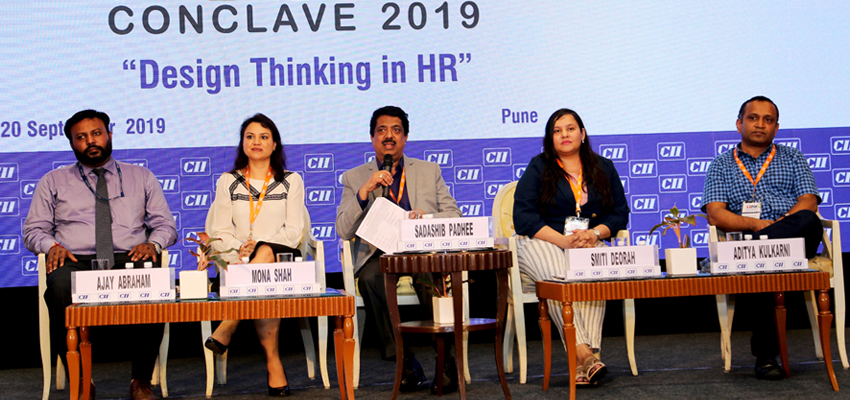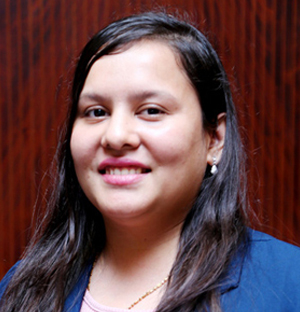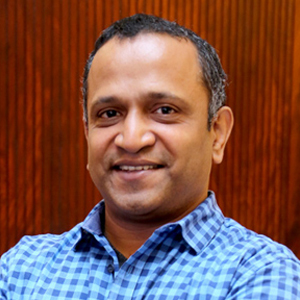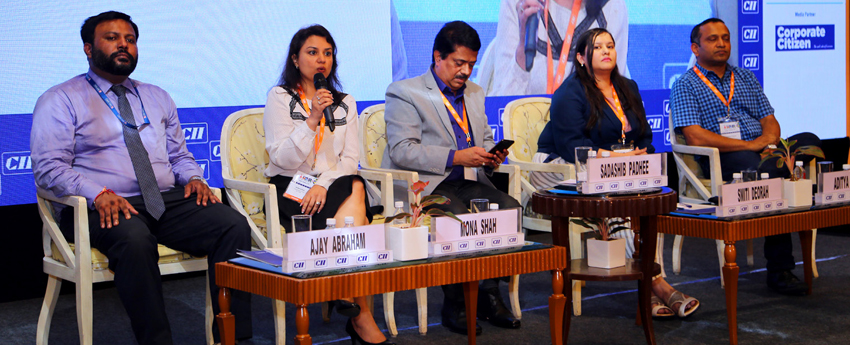Design Thinking in HR

HR tech startups will help to define product offerings that will solve HR challenges and will present opportunities to showcase their products to the decision-makers in the HR domain. They will be heard by the investors, entrepreneurs and senior executives from the human resources community. At a recently conducted session at Pune, titled, ‘Design thinking in HR’, panellists explore ideas for the digital HR workplace space by startups who are 0-5 years old in the industry explaining their ideas, technologies and business models to the mentors during the conference. Panel for the session were, Smriti Deorah, CEO & Co-Founder, Advantage Club; Aditya Kulkarni, Founder- Director, AmplifyReach; Mona Shah, Chief Solutions Officer, Sproutlogix and Sadashib Padhee (Moderator), Convenor, CII Pune HR & IR Panel & Vice President – HR & IT, Kirloskar Pneumatic Company Ltd.

“A lot of organisations now are looking at innovative ways in which they can give a certain amount of budget to the employees to be actually free to the wave they want to top-up”
- Smriti Deorah
Smriti Deorah :
Organisation and design
I’m will talk about the platform of how we can help provide extra benefits and ways for employees to earn better than what they are drawing today. Our vision is to enable organisations to engage with their employees. We started in 2014, we were working with Microsoft and Amazon in the US before this. We saw amazing programmes like running in the US and the UK, and we realised that employee engagement as a core value proposition is something that is missing in India. Especially, when we started five years ago and we decided that this was an open space and we should probably do something to disrupt this industry. We overall run with more than 250 organisations today and we have more than 9000 brands on the platform who provide exclusive benefits to the employees of multiple organisations. We are funded by a couple of good investors. We have a couple of investors like Axelor Investors, Purvi Capital, which are Chicago based.
We are talking about design thinking the whole time. And there are primarily two ways in which you can go about design thinking. As startups, our primary job is to look at the innovation piece and that is where it comes in. If you look at the landscape of things have changed in the past. A decade ago, all people would care about is salary and financial security. A lot of great organisations with Mutual Funds, insurance, banks… all these came into place. And they overall tried to innovate the financial security piece.
Now it has become a status quo with everybody. In the past 5-6 years, the focus changed into increasing the take-home salary of an employee. There a lot of reimbursement options, probably the way you submit bills and you get benefits in terms of meal vouchers and others, came into place.
Millennials and their needs
Now if you are looking at millennials, I will quote Mr Sahil, if you are going to build a product for the millennials, you’d have to either involve them or take their opinion. What the millennials are looking today is for essentially three things…
1. They are looking for workspace pride to be associated with their organisation. For example, suppose if my organisation is giving me some benefits that my friends haven’t heard of, it automatically reinforces my faith.
2. Looking for constant appreciation: It should be done regularly and in a smart way wherein you aren’t comparing the employees. But you are doing a cookie model in which 85 per cent of the organisation is getting awarded which automatically incentivises the remaining to actually come forth and start performing.
3. They don’t look at jobs as just jobs, they want to work with an organisation that offers them much more. They want to work with someone who provides them with a social community. The entire aspect of social community is lacking today and employees aren’t taking leverage of this.
Programmes:
We primarily create communities within corporates. We have six types of programmes which run.
1. You get exclusive discounts for the employees anywhere they go. Shopping, entertainment, travel, education, gyms, etc. that’s how the corporates try to resolve the problem.
2. Rewards and recognition: You can get offers in multiple places and you can use your reward points to use them. But here you can do that. It’s a holistic platform, for example, you can not only get a PVR ticket at a 20 per cent discount, but you can also redeem the points to get a 30 percent discount. The value of the points automatically increases and I can keep purchasing other vouchers with that. It comes with a recognition piece in which there is a peer to peer recognition. A lot of organisations now are looking at innovative ways in which they can give a certain amount of budget to the employees to be actually free to the wave they want to top-up. Suppose, I want to top-up 10,000 points, as an employee, I can choose whether I want to use it for car insurance or whatever insurance I want.
3. Our classifieds piece does internal buy-sell. For example, this is was very popular with us in Microsoft. In the US, you get the T-mobile phones which are basically unlocked. So, you can buy them at $200 and sell them at around $400. The seller gets an advantage, so does the buyer, as they would be selling at prices that are lower than the market rate. We create an internal buy-sell option within the organisation, where I can sell second-hand iPhones and other things because people within the organisation trust each other.
4. The last one which we have is basically a hobby club. The way the hobby club works is, suppose I have a table tennis (TT) table in my organisation and I want to find a player who can play TT with me, I can easily do that through the hobby club. I can find people of similar interests, and then they can have quora kind of setups in which there can be multiple discussions happening. I can find people of similar interest and overall it just creates a holistic way of the way an employee interacts within the organisation.
Partnership
Today, we work with more than 9000 brands. A couple of privileges that we have are, we offer medicines at 25 per cent off, through Medlife. These are repetitive offers. All our offers are long-term and infinite times usable. If you have points you can surely use them to redeem it. If you don’t have points, you can pay from your pockets.
We also have brands like Samsung which provides phones at 8-12 per cent cheaper than Amazon and Flipkart. We also have Amazon and Flipkart with us. On the offline portal, we have entities like lifestyle, home store, Shoppers Stop, etc. where you get an additional 8-10 per cent off.
We have more than 3000 dining options on the platform. We have CCD, Barbecue Nation, KFC, Baskin and Robbins and other local restaurants where you can get an additional five percent off.

“When you are working in a business environment, you are trying to market yourself, you are trying to sell something and you are trying to attract other people for your work”
- Aditya Kulkarni
Aditya Kulkarni :
I spent a good amount of time with research, in digital-advertisement technology. And what I found was that when you are working in a business environment, you are trying to market yourself, you are trying to sell something and you are trying to attract other people for your work. Taking that into cognisance, in the digital advertising spend, we saw that we are working with the brands, we are spending billions to attract customers. The minute they come up with the brand that is where the challenge of the communication gap starts and that is what we see as an opportunity which needs to be fixed. And that’s the story of our organisation.
Conversational AI Automation for HR Ops
We are working with brands which belong to the Fortune 500 company. From BFSI, telecom to several other companies, it’s been a fabulous journey of learning for us. You and I, we meet each other, we talk, we disperse and later we keep in touch through digital platforms. But the minute we come to the brands, the best thing you can give someone is a form, if not an email. We had done market research and in any organisation, whether it’s related to sales, market or HR, you mail someone and you won’t receive an answer for 48 hours. That’s what clicked us that this is an opportunity. And that’s why we say communication is required and it needs to be done on the channel of the choices of the software that you are going to have.
Look at the apps that are coming up. How many of them do you download? Your screen has limited space and you keep the apps which are most used e.g. WhatsApp, Facebook etc. And this is useful for internal communication as well. When you talk about HR, your team is your internal customer, there are prospects whom you are trying to attract to various LinkedIn sharing. The minute they come on to your site, what do you provide to them? That’s what the interesting portion becomes. We also did our brainstorming around the details and data, and we had very good numbers to back that up.
Customer on-boarding, which is for the business, same applies to the employees when it comes to HR. That is an important step and which can lead to very important information sharing.
When it comes to finding a policy for different types of organisation and the minute an organisation rises from a startup and goes to 500- 1000 employees, which is when the challenge of finding the right information comes to play. And a good amount of time gets spent in that where the worker needs to find the information quicker. And how can we do that? For example, the technology of John Deere, about an autonomous car and those kinds of projects coming up. Similarly, the natural language technology where you and I can speak in a normal language that is also evolving very fast and we try to use that to answer various types of questions.
You can install chatbot on your website which could be an intranet or a customer’s portal. It could be onto to WhatsApp or Facebook messenger or various other places. Employees can start to engage with anything as there are multiple options to play with. Services, travel-related opportunities should answer other types of benefits. And these important things help to scale the organisation. This is not only on the web as a channel but it’s available on various other portals. For a couple of customers, we already have started doing this and through this, we are launching it into partnership with various brands in our country, specifically in terms of health care and other related benefits. We have partnered with various insurance companies and with their offerings we are provided to the end customers and vis-a-vis organisations.
Now at a start what it can do? Anybody who starts on the day zero asks what is my ROI? That’s the biggest question. There are numerous areas where the organisation can start and see immediately what are the benefits and how it could be brought in. That’s where the HR services, lead management, healthcare insurance, effective related automation, different policies and different information could be available. Travel related automation is a great way possible.
The good part about this as I said, the technology of language is increasing. We are already supporting 11 languages which include a couple of European, Indian, Chinese, Japanese and Hindi. And we are looking at South-Indian languages.
Now when you start with instant communication, you get a lot of messages on WhatsApp. It starts with a good morning and ends at a good night. You cannot communicate with each and every one. And that’s where the AI portion, language understanding, comes into the picture. Your regular tasks start to help. In a nutshell, when we took a survey, we found 20 per cent of the enterprise task are repeatable and they consume 80 per cent of the time. All the seniors can remember the organisation five years back and with people growing the HR function has increased in a total number of team size. A good number of those tasks are repeat where it could be just extending the information of benefits, signing up the forms, some could be compliances and so on. All this can we did within a day zero to day 45.

“Learning and Development cannot be one size fits all. The programme that worked for my father, wouldn’t work for me or my programme wouldn’t work for anyone else”
- Mona Shah
Mona Shah :
We are a startup that started about three years ago. We started here in Pune and expanded to the US with multiple sales offices throughout India as well. Primarily we are into HR technology.
With this premise we need to continuously develop, all of us need to continuously learn; we want to make this process as easy as possible, personalised and enable it with technology. We looked into what an organisation needs. And the reason this came up is that the founders and business leaders of Sproutlogix have had corporate experience, we have seen that Learning and Development are primarily been the same for many years. Sixty years ago, when my father became the manager in the US, they put him in a leadership development programme and worked face to face with the coach on developing the leadership skills. Well a few years ago, when I was in the corporate office and I was becoming a leader, that’s the same thing that happened to me.
So, it’s time to bring in technology, use its power. I’ll tell you what an organisation needs. It needs skilled employees to do the work. Here’s the challenge. First of all, Learning and Development cannot be one size fits all. The programme that worked for my father, wouldn’t work for me or my programme wouldn’t work for anyone else.
The second thing is, learning is changing. Not just for millennials but for the rest of us as well. As there’s an influx of technology and due to globalisation, Learning and Development has to keep up, it has to be customised for me, you have put me in a workshop with a hundred other people and expect that all our proficiency level are going to be same, all our learning styles, our learning abilities are going to be same. The biggest problem, Learning and Development HR has always faced, how we show business impact. How do we show ROI? So, here’s a solution. We build a platform which uses the power of technology like AI to build personalise and customise how we develop employees.
 (L-R) Ajay Abraham, Mona Shah, Sadashib Padhee, Smriti Deorah, Aditya Kulkarni
(L-R) Ajay Abraham, Mona Shah, Sadashib Padhee, Smriti Deorah, Aditya KulkarniThe three focus areas are.
1. Skills discovery : How do we understand the capabilities of the employees and where they need to be? We work with organisations to understand this and measure and understand the employee’s capabilities. We then provide them with personalised learning solutions. As I mentioned, what works for me won’t work for others. And once we are done providing this information, we then work with the employees on their applications. As we all know we apply on 10 per cent of our knowledge that we gather. We want to focus on the rest of the percentage. And then, we measure the growth. Not to grade the journey, but understand your development.
2. We help the employees to interact with their peers and their managers. Not only to get feedback but to make sure that the feedback is constructive. We help coach and guide, managers, peers and other people to get constructive feedback using Learning and Development. The next thing that we provide is to ensure that we provide learning recommendations. This is based on how we understand you as a learner. Once you start using the platform, we understand whether you performed better when you watched a video or when you have read the article. We also understand things about from the feedback that is given to you. Feedback might be something like, Mona, your confidence is fantastic when you speak but you need to slow down a bit. If that is the feedback my manger has given to me and my reportee is given to me. That feedback needs to be acted upon. This feedback can turn into a learning form. We turn that into a recommendation to the employee to help them understand how they can improve and in what area they need to improve.
3. The next thing is our coachbox. This makes conversation very engaging for users. It helps them get advice and assistance at any time. The coachbox will guide you on the workplace-related issue. Some of the clients that we have worked with are some of the fortune 500 companies to some of the very small companies. This is a tool for the employee. So, the size does not matter.
We understand how employee development impacts the bottom line and business relationship. Along with that, we have a lot of experience in building solutions, building technology, working with using technology and enterprise solutions.